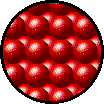    |
||||||

The Particle Theory - states of matter |
||||||
|
The Particle Model is a model of matter. That means it is a way to make our thinking about the complex reality of matter much simpler. It explains most types of matter very well and is easy to picture in our heads. Rules for being a 'Particle'Particles are very small - their size is negligible. Particles are identical - to simplify our model we will ignore Chemistry - same mass - no awkward shape - no polarity (charge differences within the molecule) Particles attract one another: the closer they are the stronger the attraction (therefore in solids and liquids attraction is very strong but in gases it is negligible). Particles are in constant random motion (hence the word 'kinetic' in the name of the theory - random means no preferred direction - as many move in one direction as the opposite - all of the movements are 'balanced' or cancel each other out - no nett (resultant) movement. The motion is a combination of these three types:
The arrangement of particles within each of the three main states of matter can be used to explain their general properties. There are some substances that are difficult to categorize - for example sponge, rubber etc. Their structures make them not quite fit the model's examples. In an examination the examiner will be thinking of a rigid solid (like a metal block) when speaking of a solid... but the ones that are difficult to categorize do have interesting structures and you will learn more about them at higher levels.
|
||||||
 |
||||||





